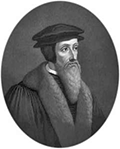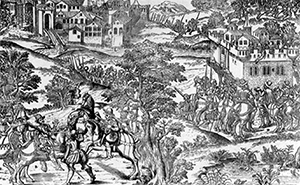The French Wars of Religion
Part 1: Early Struggles The Wars of Religion consumed French military and political efforts for nearly 40 years in the 16th Century. Deaths and injuries numbered in the millions. 
Europe in that century was awash with discussions and conflict regarding religion. Perhaps the most influential leader of what came to be called the Protestant movement was the German monk Martin Luther, whose posting of the 95 Theses on a church door in Wittenberg in 1517 was one of the events that kicked off more than a century of sectarian struggles, many of them violent. Another well-known early Protestant leader was John Calvin (left), who was born in France in the early 16th Century and traveled throughout Europe, preaching the need to re-examine religious beliefs and practices. Calvin's ideas appealed to many people in France, and followers of Calvinism came to be known as Huguenots. (The origin of the term is uncertain.) The French King Henry II had signed the Peace of Cateau-Cambrésis with German princes and with Spain's King Philip II in 1559. Those princes were Protestants. At the same time, Henry was a devout Catholic and targeted Protestants in his own country. Just after his ascension, he installed the Chambre Ardente in the Parlement of Paris, in order to try heretics. In the last year of his reign, he issued the Edict of Écouen, to further religious prosecution. He particularly targeted the Huguenots, with the 1551 Edict of Châteaubriant, which included a ban on unapproved books. Thus, the doctrine of religious intolerance had been set. When Henry II died, in 1559, his wife, Catherine de Medici, presided over the kingships of three of his sons, ruling as regent for all of them. 
First up was Francis II, who ascended the throne when he was 15. One thing that the young king really liked doing was hunting. He liked taking his new wife, Mary, Queen of Scots, with him, and so they went on several hunts together. While they were thus occupied, Catherine and the Guise family were running the government, with François Guise running the army and Cardinal Charles Guise taking care of financial and political matters. This didn't sit well with a number of people in France, particularly the Huguenots, who had been victims of persecution before. Francis had chosen to maintain those policies, and the Huguenots had had enough. On March 17, 1560, a large group of people, Huguenots among them, stormed the royal cháteau at Amboise; royal security had no trouble stopping the attack, and the king later ordered the leaders of the attack executed. Rather than keep the peace, these executions served to inflame the populace, and riots proliferated in various cities, notably Lyon and Provence. King Francis sent royal troops to disperse the rioters. Francis was on the throne for 18 months before he died, on Dec. 5, 1560. At that moment, his younger brother Charles became King of France; he was 10. As before, Catherine assumed the reins of government. A 1561 religious conference known as the Colloquy of Poissy came to no real reconciliation. Catherine was a Catholic but wanted to keep the peace more than prosecute a religious vendetta. She had the government issue the Edict of Saint-Germain, in January 1562, granting some demands made by Huguenots. The response from the powerful Catholic Guise family was to order a wholesale killing of Huguenots in Wassy on March 1. This came to be known as the Massacre of Wassy. Unsurprisingly, Huguenots took up arms against the government in response. Fighting raged across the realm for a number of months. Leaders on both sides, including Francis, the Duke of Guise, were killed. Catherine again stepped in, organizing a truce in March of 1563. The peace held, and Charles and his mother embarked on a tour of the realm. Next page > Later Struggles > Page 1, 2 |
|
Social Studies for Kids
copyright 2002–2026
David White




